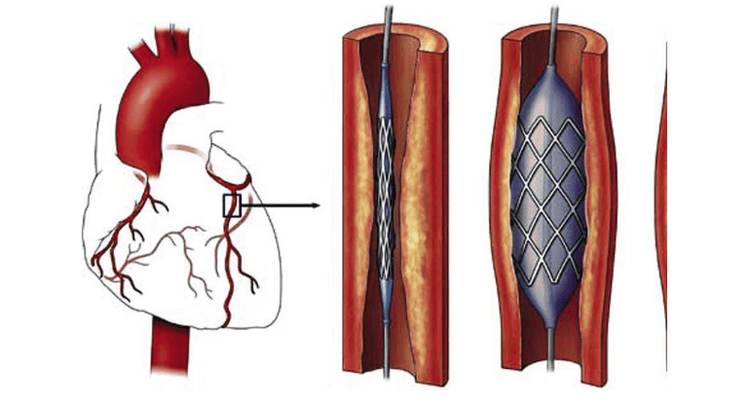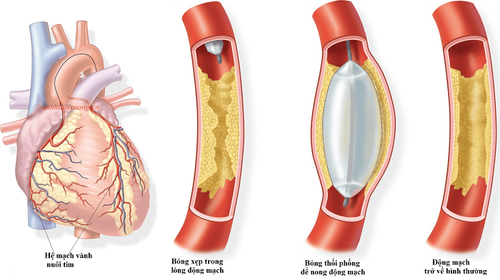This is an automatically translated article.
The article was consulted with Dr. Nguyen Van Duong - Interventional Cardiologist - Cardiovascular Center - Vinmec Central Park International General Hospital.Coronary artery disease is a disease with high morbidity and mortality. Current treatment methods for coronary artery disease include medical treatment, intervention and surgery. Percutaneous coronary intervention is a non-surgical treatment that both relieves symptoms and resolves the cause of the narrowing of the artery.

1. Which cases need percutaneous coronary intervention?
Percutaneous coronary intervention is a procedure that involves catheter intervention, inserting a wire through the lesion (stenosis, occlusion), and then inserting a balloon and/or stent to widen the stenosis/obstruction and placing a stent to open the lumen. circuit . Percutaneous coronary intervention is sometimes also accompanied by other special procedures such as thrombus suction, plaque drilling...Percutaneous coronary intervention is indicated in the treatment of coronary artery disease, specifically Possible:
Stable angina unresponsive to medical treatment. Stable angina, myocardial ischemia (positive stress test or positive myocardial perfusion scan) and damage to the coronary artery that supplies a large area of myocardium. Unstable chest pain/acute myocardial infarction without ST elevation but high risk stratification. ST-segment elevation acute myocardial infarction. Angina appeared after the patient performed coronary artery bypass surgery. After percutaneous coronary intervention, there were symptoms of restenosis. Angioplasty and percutaneous coronary stenting are contraindicated in the following cases:
Lesions not suitable for intervention (eg, diffuse severe lesions, multiple coronary lesions, distal lesions, ...). Coronary artery damage has a high risk of death if that coronary artery becomes blocked again during intervention. Patients who are prone to heavy bleeding (low platelet count, coagulation disorders,...) do not adhere to treatment before and after intervention procedures. Coronary re-stenosis in many locations after intervention...
2. Benefits of percutaneous coronary intervention
In contrast to coronary artery bypass graft surgery, which requires a thoracotomy, percutaneous coronary intervention is performed by simply opening a small hole in the skin to insert a small catheter (catheter) into an artery in the thigh or wrist. Patients only need local anesthesia, not anesthesia like open surgery, so the patient remains awake and does not feel pain during the procedure.The stenting process is quick, within about 1 hour and most patients can go home in 1-2 days. Angioplasty and percutaneous coronary stenting help resolve the narrowing of the occlusion in the coronary arteries, improve myocardial perfusion, and allow patients to function normally without angina.
In the case of a patient with a myocardial infarction, along with drug treatment, coronary intervention helps to reperfuse coronary blood vessels to limit myocardial damage due to ischemia, and also helps prevent occlusion. recurrent narrowing, limiting the return of angina.
3. How is percutaneous coronary intervention performed?
Percutaneous coronary intervention is carried out with the following steps:The patient is explained by the doctor about the procedure, possible complications and signed a commitment to perform the procedure Before the procedure, the patient antiplatelet drugs (aspirin, clopidogrel). Check the co-morbid conditions, kidney function, medical history such as history of gastrointestinal bleeding, coagulation disorders, allergy to contrast agents... Disinfect the procedure area, cause Local anesthesia Interventional catheterization After selective coronary angiography, identify lesions, locate the need for intervention Insert a special guide catheter to guide the artery to the coronary artery. Then, a very thin, thin wire is threaded through the upper catheter to reach the site of injury and then through the blockage in the coronary artery. Depending on the damage to the coronary artery, the doctor may use a balloon. Special small tubes are inserted to dilate the occluded stenosis in the coronary artery (can be balloon angioplasty alone, no stenting or balloon angioplasty combined with stenting) One or more stents will be placed at the site of injury to avoid visible Re-stenosis after intervention After stenting, re-scan coronary angiography to ensure no complications (coronary artery dissection, slow flow, ...)

4. Notes after performing percutaneous coronary intervention
After the procedure, the patient should rest in bed, if the radial pulse is intervened (wrist puncture), the hand should be raised and the hand is stabilized for better hemostasis. If the femoral artery is inserted, the patient should be immobilized for 6 to 8 hours, especially the leg on the side of the procedure to ensure that the puncture has stopped bleeding. Remember to hold the puncture site when you cough or sneeze. Call the nurse immediately if you notice recurrent bleeding or pain in the area of intervention. Patients should drink more water to prevent hypotension and kidney disease due to the effect of contrast agents.After being discharged from the hospital, it is necessary to pay attention to taking full medicine and having regular medical examination under the guidance of the doctor. If chest pain reappears, the patient should seek medical attention immediately.
Apply lifestyle changes to prevent recurrence such as:
Well control indicators such as blood pressure, blood sugar, blood fat Do not smoke, do not drink alcohol. Practice proper exercise and rest. Percutaneous coronary intervention is a difficult technique, requiring medical facilities to have a team of highly qualified and experienced doctors and nurses in the field of Cardiology and a system of facilities and equipment. be modern. Vinmec International General Hospital is one of the most prestigious medical treatment units for cardiovascular diseases in Vietnam. Vinmec's Cardiology Department has always received much praise and satisfaction from domestic and international customers, being the pioneers in successfully applying the world's most advanced techniques in the treatment of cardiovascular diseases.
A team of highly qualified and experienced specialists: qualified doctors from Master's to Professor's and Doctor's degrees, reputable in medical treatment, surgery, interventional cardiac catheterization. Intensive training at home & abroad. In particular, Prof. TS.BS Vo Thanh Nhan - Cardiology Director of Vinmec Central Park was recognized as the first and only expert in Vietnam to be awarded the "Proctor" certificate on TAVI. State-of-the-art equipment, comparable to major hospitals in the world: The most modern operating room in the world; The most modern silent magnetic resonance imaging machine in Southeast Asia; The CT machine has a super-fast scanning speed of only 0.275s/round without the use of drugs to lower the heart rate; The 16-sequence PET/CT and SPECT/CT systems help detect damage to the cardiovascular organs early even when there are no symptoms of the disease. Applying the most advanced advanced cardiovascular techniques in the world in treatment: Painless open heart surgery; Percutaneous aortic intervention without general anesthesia; Treatment of mitral regurgitation through the catheter has a success rate of 95%; Ventricular-assisted artificial heart transplantation for patients with end-stage heart failure prolongs quality of life beyond 7 years. Cooperating with leading cardiovascular centers in Vietnam and the world such as: National Heart Institute, Cardiology Department of Hanoi Medical University, University of Paris Descartes - Georges Pompidou Hospital (France), University of Pennsylvania (France), University of Pennsylvania (France), University of Pennsylvania (France). United States)... with the aim of updating the most modern cardiovascular treatments in the world. To be examined and treated with leading Vinmec cardiologists, please book an appointment online at the website or contact Vinmec Health System nationwide for service.
Please dial HOTLINE for more information or register for an appointment HERE. Download MyVinmec app to make appointments faster and to manage your bookings easily.
The article references the source: Vietnam Heart Association













